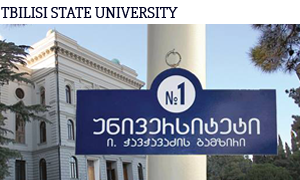
FACULTY OF HUMANITIES
TSU SCIENTISTS MAKE A UNIQUE DISCOVERY
The spring of 2015 may enter history as an exceptional date for science, with the unique discovery of artifacts by researchers and students at Tbilisi State University’s archaeological site at Grakliani Hill, in the Kaspi district of Georgia. This discovery is a breakthrough that may well change the history of writing in Georgia – and in the world. A group of scientists from TSU assert that the unique inscriptions represent an entirely different and unique type of script that has no analog elsewhere._Page_6.jpg) In a temple with two altars dating to the 7th century BC and dedicated to a fertility goddess, inscriptions are visible on both of the altar pedestals. This new discovery shows that Georgia has at least a 2700-year history of writing. This and previously discovered materials might well change the history of eastern Georgia, particularly Kartli of the 7th and 6th centuries BC.
In a temple with two altars dating to the 7th century BC and dedicated to a fertility goddess, inscriptions are visible on both of the altar pedestals. This new discovery shows that Georgia has at least a 2700-year history of writing. This and previously discovered materials might well change the history of eastern Georgia, particularly Kartli of the 7th and 6th centuries BC.
Professor Vakhtang Licheli, Head of the archaeological expedition and Director of the TSU Institute of Archaeology, attaches an immense importance to the newly discovered artifacts. Georgia thus enters the elite of key civilizations that have used writing for millennia. The writing in the temple is well-preserved on both altars.Several letters are carved on one, facing westwards, and the pedestal of the other altar is completely covered with similar inscriptions. They are so important that they surpass the scope of Georgian science alone, and have become subjects of international research, and will change world writing history.
Pic.: Inscriptions discovered in spring 2015 during archaeological digs in Georgia belong to a hitherto unknown writing.
Grakliani Hill is an archaeological monument where the 300,000-year development of humans has been confirmed from the  Stone Age to Antiquity. Artifacts discovered within ten layers, and which comprise several periods, include tools belonging to primitive cultures – such as cult items and a “pharmaceutical device”, a kind of spatula for mixing drugs and solutions. These objects provide key information.
Stone Age to Antiquity. Artifacts discovered within ten layers, and which comprise several periods, include tools belonging to primitive cultures – such as cult items and a “pharmaceutical device”, a kind of spatula for mixing drugs and solutions. These objects provide key information.
This intriguing architectural picture gradually emerged as a block of buildings situated close to each other, yielded significant objects such as a golden disc from the 5th –
4thmillennium BC. Its only analog is found in Suzar, Iran, with a seal from the 4th millennium BC. A similar object was found in Southern Mesopotamia. There are several cult rooms including a “cult mill”, a three-part hand-mill with which holy flour was ground to bake bread and sacrifice it to idols. The altar platform discovered at Grakliani Hill is unlike any other in the world, and associated with the cult of the Great Mother, who is depicted at the altar.
Archaeologists from Ivane Javakhishvili Tbilisi State University began working at the Grakliani Hill site in 2007, when a station for scientific research and field work was created. The status of National Monument was granted to the site in early 2015. According to a recent decision by the Ministry of Culture of Georgia, an open museum at Grakliani Hill will be constructed; in cooperation with the National Agency for Cultural Heritage Preservation a protective roof covering of the site has already been installed.
Professor Licheli’s preliminary research on the inscriptions at Grakliani Hill was published by the Georgian National Academy of Sciences in the materials of the Kartvelology Congress held in November 2015. Professor Licheli has made several foreign presentations about this unique discovery – twice in Germany and once in St. Petersburg during the 8th International Conference of Iranists and Orientalists. The inscriptions have created significant interest in several institutions, and for example the Universities of Bordeaux (France) and London (Great Britain) have already expressed their wish to study them.




